Everybody knows the term “bad apple.” But, some people forget that the whole phrase is, “One bad apple is enough to spoil the whole bunch.” Similarly, in a toxic work culture, one person with a bad attitude can poison otherwise good employees’ enthusiasm. These people are also sometimes called energy vampires because they leave their coworkers feeling drained. They spread gossip to stir up trouble or take too much credit when it’s not due while passing off their failures onto others. Those characteristics can spread quickly and leave an office in complete disarray. As a leader, you’re 100% in charge, so it’s critical to be able to spot a toxic work environment and know how to fix it or prevent it from happening in the first place.
An Ounce of Prevention is Worth a Pound of Cure
Like poison, toxic workers and workplaces will begin to make people sick. A toxic work culture leaves employees feeling depressed, anxious about going to work, tired, and sometimes physically ill. That leads to a lack of accountability, lackluster enthusiasm, and short fuses in the office.

The ramifications of creating a toxic work culture may not be readily apparent. Still, it always shows itself sooner or later. That’s why it’s best to prevent any improprieties before they happen. Otherwise, managers and business owners will be left playing catch up, and there’s a very real cost involved with that.
Remember what Marcus always says. “The customer is not No. 1 to me. They’re No. 2, right behind the employee.” A toxic workplace is expensive, and it destroys employee happiness.
Toxic Can Mean a Lot of Different Things
Toxic workers and environments can take many different forms. It’s not always as easy as identifying a racist or homophobic worker. Sometimes, toxicity takes the form of micro-aggressions, favoritism, punishments, or dismissive comments. Managers have to identify both the obvious and subtle things that lead to a toxic work environment.

It’s easier to fire or reprimand someone who acts blatantly awful. Sometimes, though, employees and managers need to dig a little deeper. Does anybody in your company feel bullied? Are managers gaslighting employees or putting anyone down, or playing favorites? These are all signs of toxic work culture.
Marcus says, “People for me is the only reason that businesses fail or they survive.” Make sure to take care of your people and make them feel safe.
What Creates a Toxic Work Environment?
From your entry-level staff up to the C-suite executives, everyone has the potential to create a toxic work environment. Luckily, everybody has the power to stop it, too. Any company that doesn’t have clearly stated values and rules is opening the door for toxic behavior. Bad communication leads to distrust. That’s why it’s essential to have an open office with free communication. As a manager, one of your jobs is to allow your employees to feel free enough to share their problems with you. Marcus always says, “My number one asset is vulnerability. If you can be more vulnerable and more human, I’m telling you that you will do more business.” If employees are overworked, worried about office politics, or being harassed and have nowhere to report problems, your company will fail.

Five Warning Signs to Look Out For
1. Me-me-me management
If the manager is never wrong, who’s going to point out that the car is heading toward a cliff? A job title doesn’t come with the right to put other people down or take someone else’s credit.
2. The rumor mill
Gossip and rumors are meant to exclude people. That’s their only purpose. The next time you hear some juicy details about a coworker or employee, keep in mind that whoever told it to you is probably doing the same thing behind your back.
Shut it down quickly and remember to only “surround yourself with good people,” as Marcus says.

3. Employee retention
A constant rotation of employees usually means there’s a toxic work culture at play. If there is nothing good tying workers to their job, they won’t stick around and wait for it to get better. They’ll leave.
4. Unconstructive feedback
Giving feedback and criticism when it’s warranted is useful. But, if there isn’t any positive feedback, then it’s just piling on unfairly.
Watch out for sayings like, “I don’t care how it makes you feel,” or “Why do you always do that the wrong way?” Criticism only works when employees are also shown how to succeed next time.

5. Sick calls
A Toxic work environment leads to employee fatigue and burnout.
Stress causes people to feel sick, and that’s a reflection of poor management because employee satisfaction leads to a healthier business.
Remember what Marcus says. “If the employee is happy, then the chances of the customer being happy are exponentially better.”

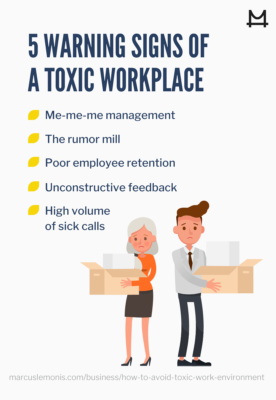
Three Strategies to Prevent a Toxic Work Environment
1. Be generous with your praise. It’s a stereotype that the business world is ruthless. Spread positivity in your company and you’ll see a change in attitudes. If you witness an employee trying to take credit for other people’s work, rectify the situation and make sure you give credit where credit is due. If a team worked on a successful project, take time to speak with every member and let them know that you appreciate their hard work individually. As Marcus says, “There is no being generous to a fault. Because there is no fault in being generous.” As the boss, you lead by example.
2. Set up a formal feedback process. Communication is key. Ensure there is a discreet way for your employees to provide both positive and negative feedback about their coworkers and managers. Guarantee that your process is private and leadership won’t use their comments against them. Employees work harder and are more efficient when they don’t have negative feelings weighing them down or fear reprisal.

3. Forget punishments and refocus on training. Marcus puts it this way. “Your job as the CEO of the business is to be the coach. Rather than running people under the bus, you’ve got to get them on the bus with you.” Publicly chastising or punishing employees can create a toxic work culture and build in-groups and victimization. When an employee fails, it’s an opportunity to reintroduce training to make sure it doesn’t happen again. Also, own up to your own mistakes. That makes the office feel equal. It’s a great idea to treat everyone, even yourself, as part of the same team.
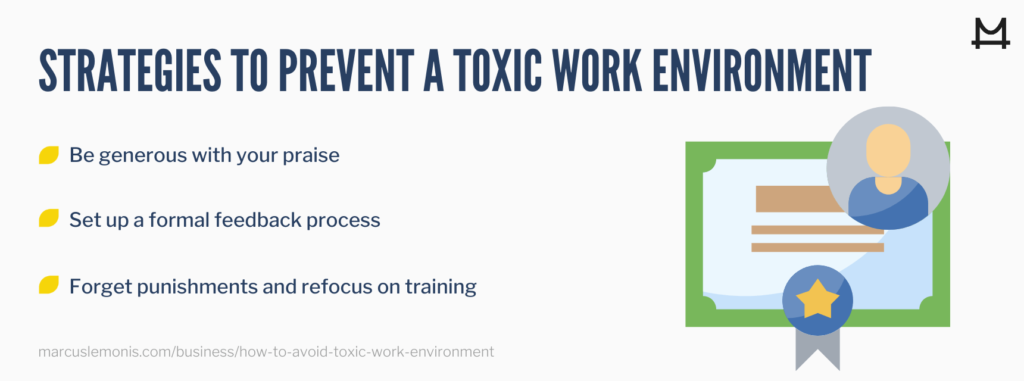
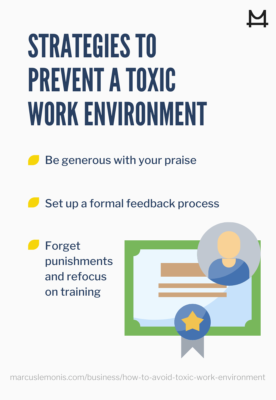
Turn Around a Toxic Office With These Three Strategies
1. Admit when it happens. If you see something happening in your office that doesn’t fit with your business ethics, own up to it immediately. Problems don’t resolve themselves. The first step of fixing a toxic work environment is sitting down with the parties involved and clearing the air. This can be uncomfortable, but it’s vital.

2. Make sure you’re speaking with every employee. In 2001, Campbell’s, the food and snack company widely known for its soups, was in a tough spot. Its stock was dropping, and its new CEO, Douglas Conant, admitted that a toxic work culture plagued the company. Mr. Conant decided to turn the company’s fortunes around by engaging with as many employees as possible. His solution was to attach a pedometer to his belt, don a pair of walking shoes, and interact with every person he saw, aiming for at least 10,000 steps a day. His employees shared their daily schedules, issues, and goals.
He shared corporate objectives and celebrated contributions. In less than ten years, Campbell’s employee engagement went from nearly the worst in the Fortune 500 to almost reaching the top. Sales rose, and the company outperformed the S&P 500. (Bariso, 2018).
3. Observe, report, and act. Communicating is essential, but bosses need to take time to observe their teams without interrupting. You can glean a lot of information by watching teams work. Where is dysfunction coming from? Who is spreading gossip? Is there one employee who always has to be the center of attention? Is there a black sheep in the group? Is there a flaw in your process that inherently creates tension? If you find an answer to any of these questions, then it’s time to take quick, decisive action. Whether it’s letting someone go, reintroducing stricter training programs, or reworking a flawed process, it’s up to the boss to make bold, clear decisions. As Marcus says, “You gotta pick a path. And you gotta GO!”

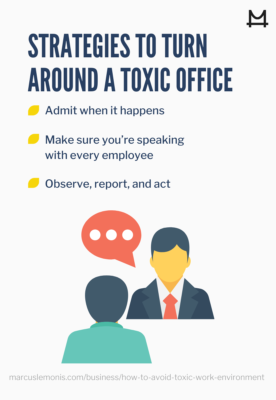
How to Handle an Employee Who is Being Toxic
Nobody likes having awkward conversations, but it comes with the territory. If you have an employee creating a toxic work environment, it needs to be dealt with quickly. These three steps can help you initiate that conversation.
1. Face-to-face feedback. Like a person who has had one-too-many beers and starts talking to strangers, toxic employees may be completely oblivious that their behavior has crossed a line. Generally, people are too focused on themselves to see the broader impact of their conduct. A face-to-face meeting, in private, can help a toxic employee come to terms with their actions. Without sugarcoating anything, explain what you have observed and how it has impacted your team. You have to lay out all of the facts objectively and without spite. You aren’t there to make them feel bad. You’re there to help. Give the troubled employee clear goals and assure them that you will check in with them to make sure they’re changing their behavior.
2. Document their behavior. As a manager, it’s up to you to ensure your whole team works well together. Unfortunately, that means that sometimes it’s necessary to let toxic employees go before their behavior creates a toxic work culture. To cover yourself and your company, document their actions and behaviors. Write everything down and mark the dates when transgressions occurred. Suppose you need to refer back to your documents later. In that case, it’s a good idea to be able to prove a pattern of misbehavior. Include your attempts to remedy the situation, the resources you provided to help them change, and any formal complaints that may have been lodged against them.

3. Don’t let toxicity infect you. There’s a reason why toxic people are called energy vampires. They suck up all of your time, enthusiasm, and happiness. As the leader of your company, you set the tone for everyone around you. Make sure you stay supportive and happy. Remember why you are in your business, and make sure to take care of yourself. Stay moving, get plenty of sleep, take walking breaks from work, or go on a short vacation to clear your mind. Encourage your employees to do the same. Sometimes, if you starve an energy vampire, they can realize their actions were inappropriate.
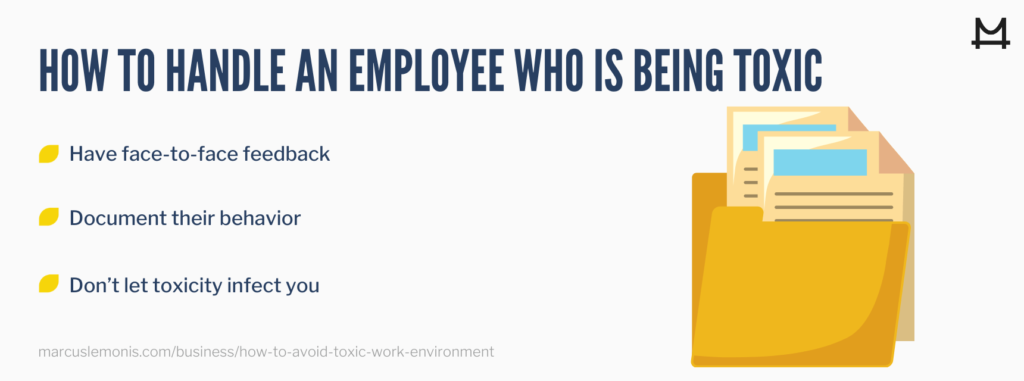
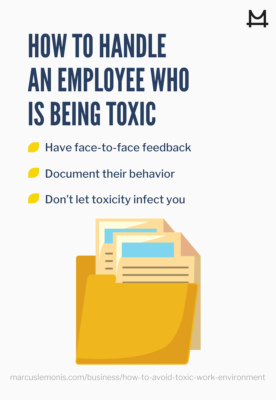
Toxicity is Bad But if Handled Correctly, Could Lead to Some Good
Preventing your office from becoming a toxic work environment is the best course of action. Still, sometimes things are out of your control. A troubled employee needs to be spoken to about their actions, and it’s up to management to figure out a solution. As Marcus says, “The key to business isn’t being smarter or wealthier, it’s being able to connect to people and relate to them.” Empathy, feedback, and setting clear goals can help to correct someone’s course. If that doesn’t work, they need to be separated from the rest of the team. There are few problems in business that can’t be solved; it just takes a good leader.
- How Can You Embed Trust In Your Leadership Style?
- Which Tips From The Above Can Help Build Trust in the Workplace?
Bariso, J. (2018, Aug. 16). Can you fix a toxic workplace? You can–if you do these 5 things every Day. Retrieved from https://www.inc.com/justin-bariso/can-you-fix-a-toxic-workplace-you-can-if-you-do-these-5-things-every-day.html





